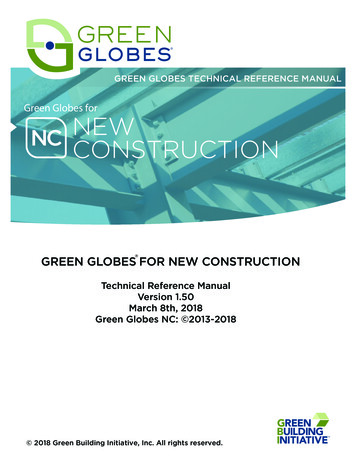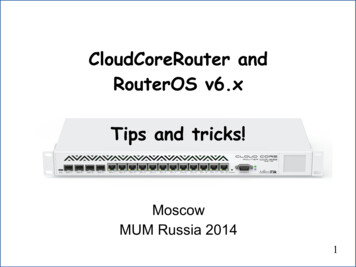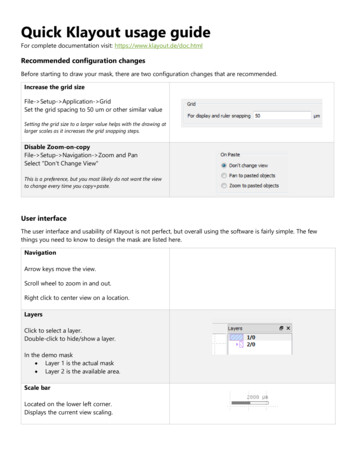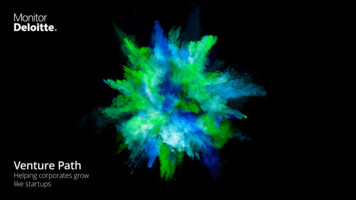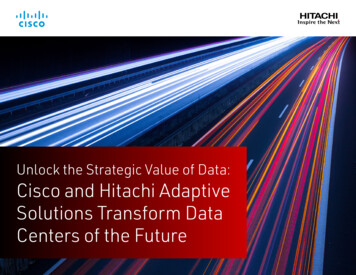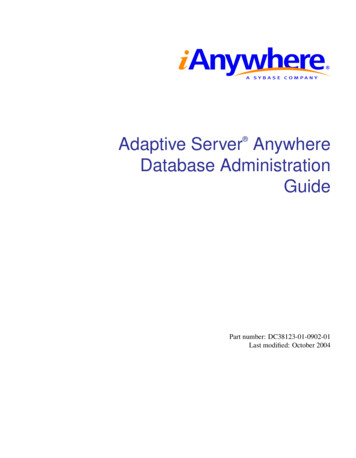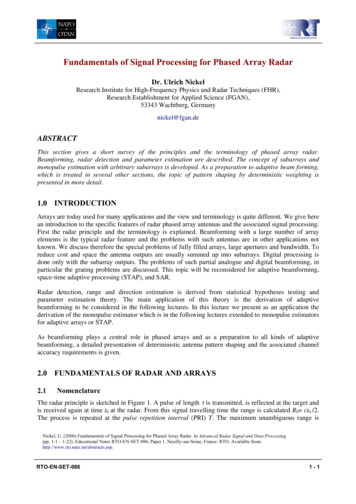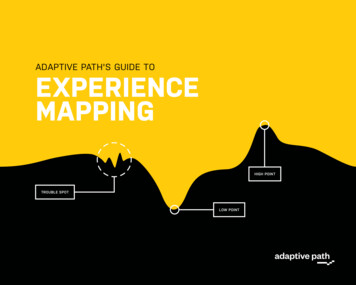
Transcription
Adaptive Path's Guide toexperienceMappingHIGH POINTTROUBLE SPOTLOW POINT
First EditionPublished August 2013Adaptive PathPier One, Bay 2San Francisco, CA 94111adaptivepath.comWritten and designed inSan Francisco and AustinWe love our ideas to spread. This license allows you to remix, tweak,and build upon our work non-commercially. When doing so, you mustacknowledge Adaptive Path. When in doubt, just ask us. We won’t bite.For more information on what you can do with the content and ideascontained in this guide, go here: http://creativecommons.org/licenses/by-nc/3.0/ or send a letter to Creative Commons, 444 Castro Street, Suite900, Mountain View, California, 94041, USA.
Of course, customers don't care about these efforts. They careabout meeting their needs across touchpoints and across thecompetitive landscape.When done well, an experience map illuminates the holisticcustomer experience, demonstrating the highs and lows peoplefeel while interacting with your product or service. The processof mapping uncovers the key customer moments that, onceimproved, will unlock a more compelling and more valuable overallexperience. We've used experience mapping in our practice,among other methods, to generate insights, support newinitiatives, and build stronger futures for the organizations wepartner with.Brandon SchauerCEOmapping the futureOrganizations collectively spend billions ofdollars each year on experiences intendedto attract, serve, and retain customers.They build new stores and launch newwebsites; answer thousands of questionsin call centers; market, advertise, andpromote in multiple channels; experimentwith trendy mobile apps; roll out newproducts; and re-engineer services. In short,organizations create and manage a myriadof touchpoints that they want to add up toa differentiated customer experience.03Our mission at Adaptive Path is to guide our clients towards greathuman experiences. We've created this guide for others who areready to take on that challenge.As you collaboratively create and use your experience map, let usknow what you discover!
The Value ofExperienceMappingAn experience map is a strategic tool forcapturing and presenting key insights intothe complex customer interactions thatoccur across experiences with a product,service, or ecosystem. At the heart of anexperience map lies the customer journeymodel, an archetypal journey created froman aggregate of all customers going frompoint A to point B as they attempt toachieve a goal or satisfy a need.The activity of mapping builds knowledgeand consensus across teams andstakeholders, and the map as artifactallows you to create and support bettercustomer experiences. In short, experiencemapping is a journey that can involve andimpact your entire organization.04Customers are increasinglychoosing products and servicesbased on the quality of theexperiences they have with them.These experiences often break down when they span multiplechannels. As a result, organizations need a holistic, humancentered view of the experiences they create. In short, they needa map.Advances in technology and changes in customer expectationsare placing more emphasis on the interconnectedness ofchannels and touchpoints that support customers attempting tosatisfy their goals and needs. Smart organizations have realizeda lack of interconnectedness is a major competitive risk. A fewexamples: Retailers are grappling with new customer behaviorsthat have changed the very essence of what an in-storeexperience is and can be. Healthcare providers are seeking new ways to providepatient-centered continuity of care while maintaining qualityand minimizing cost. Financial institutions, in response to growing regulation,are adopting new cross-channel service approaches todifferentiate their brand and products.
New challenges require new approaches. Organizations arerecognizing the need to think holistically, but they are strugglingto do so. Projects often focus on individual touchpoints,technologies, and features without a clear picture of the totalcustomer experience, and ownership exists for touchpointsand products, but not for the customer journeys that cutacross them. This verticalization of functions and roles withinorganizations prevents individuals from collaborating, andprevents them from seeing how their work fits within the overallcustomer experience.A failure to examine the customer experience holistically andin context can lead to failure in meeting your customers’needs. Making sound decisions and investments requires asolid understanding of those needs, associated behaviors, andunderlying motivations. Experience mapping is directly aimed atgrappling with and conquering this type of complexity.Some key DefinitionsTouchpoint: A point of interactionbetween a person and any agentor artifact of an organization.These interactions take placeat a certain point in time, in acertain context, and with theintention of meeting a specificcustomer need.Channel: A medium of interactionwith customers or users. Print,the web, mobile, voice calls, andbrick and mortar locations are allcommon channels for reaching outto and interacting with customers. Achannel defines the opportunities orconstraints of a touchpoint.More: e-construct-of-channels05The Value PropositionCreate a shared frame ofreference around the customerexperience.Build organizational knowledge ofcustomer behaviors and needsacross channels.Identify specific areas ofopportunity to drive ideation andinnovation.Distribute key customer insightsin a form that is both usable andeasy to understand.Further organizational evolutiontowards customer-centeredthinking.
Experience MappingThe four steps to making sense ofcross-channel customer journeysuncover the truthchart the courseTell the storyuse your mapStudy customer behavior andinteractions across channelsand touchpointsCollaboratively synthesize keyinsights into a journey modelVisualize a compelling storythat creates empathy andunderstandingFollow the map to new ideasand better customer experiencesThe ActivityExperience mapping is a collaborative, iterative process for synthesizing and visualizingthe holistic customer experience. The activity of experience mapping results in anartifact – an experience map.06The ArtifactAn experience map presents, with richness and depth, keyinsights into your customers' complete experience. It is atool that supports charting new courses of action.
You want to tell astory, but it has tobe a true story.STEP 01uncover the truthThe value of an experience map is directly tiedto the quality of insights it communicates.Piecing together the big picture of howand why customers are interacting withdifferent channels, touchpoints, productsand services is where your journey begins.Start with the obvious, don't reinvent thewheel, talk to your customers, never relyon just one data source, and be iterative!07As a best practice, we recommend you scour your organizationfor existing data and insights relevant to the experiences youare attempting to map. It will help you get started, while bringingfocus to your research around remaining, unanswered questions.While doing new research takes more investment of time andmoney, it’s a critical step in the experience mapping process,to ensure you end up with an artifact you can confidentlyuse to support strategic thinking.
As you work toward this understanding, look to a variety ofinformation sources. For early stage discovery, call center logs,customer satisfaction surveys, or existing personas could beexcellent resources. Your research should collect insights thatadd breadth and depth to the existing knowledge you uncover,and for this, talking to customers is indispensable.Leverage your existing research and subject matter experts,but never rely on just one data source. Triangulate your problemspace to get the full picture, and let the process tell you if youstill have knowledge gaps. In order for others to buy into thestory your map will tell, they need to know it’s an authentic storybuilt from strong insights based on real data.TOI VALENTINEExperience Designerdiscovery with rigorThe research and discovery process isan essential investment to ensure thatyour experience map captures the fullcustomer story. Not everything you findwill end up in your experience map, butthe value at this stage is developing afirmer understanding of both the customerexperience and the context around it.08As you collect your data, don't expect it to be organized.Research and discovery is all about assembling the parts thatlet you build a strong foundation for your experience map.
The BuildingBlocks ofExperience MappingWe recommend sorting your researchand discovery work into building blocksby asking yourself key questions alongthe way. We've provided a few examplesfor Doing, Thinking, and Feeling to helpyou get started.09QualitativeB U ILD ING B LO C K SHuman experience is complex, and mostlyintangible. Yet the challenge of experiencemapping is to uncover, little by little,critical information about your customers’experiences. Through trial and error, we’vedeveloped a simple framework to guidethe discovery and research work requiredin the experience mapping process. Wecall them building blocks. The key buildingblocks are Doing, Thinking, and Feeling, butto understand the full context of customerexperience, we also consider Place, Time,Devices, and Relationships. Don't forgetChannel and Touchpoints!R ESE A R C HD ISC OV E DEVICESPLACEDoing What actionsare customers takingto meet their needs?What are their keybehaviors?FEELINGRELATIONSHIPSTIMEThinking How dopeople frame andevaluate theirexperience? Whatdo they expect?TOUCHPOINTSFeeling What emotionsdo people havealong their journey?What are the highs?The lows?
QuantitativeResearchMany insights can be drawn fromreviewing web analytics and diggingdeep into data sources that reveal whatcurrent customers are doing when theyinteract with your organization. Pairedwith customer satisfaction data, you canspot issues in your customer funnel or seewhich channels and touchpoints generallyget higher or lower marks.In addition to analyzing existing data,you may find it useful to create a surveytargeted at existing and prospectivecustomers. A survey can answer basicquestions, help validate what you learn inqualitative studies, or yield insights thathelp prioritize the focus of your customerinterviews. It may also make stakeholdersfeel more comfortable that the experiencemap is based on a large enough samplesize of customer data.We're big fans of quantitative researchwhen it comes to experience maps.However, customer conversations andobservations are your primary tool tolearn, identify patterns, and capture therichness of human experience.10
Qualitative ResearchHaving conversations with customers is a common and reliablysuccessful method used to gain insights for an experience map.You'll want them to focus on a story that is relevant to theproduct, service, or problem area you are investigating. Whenpossible, interviewing or observing customers in their naturalsetting will provide you with the richest data.We recommend following a directed storytelling technique thatguides the conversation with a series of open-ended questions.Your goal is to encourage the paticipant to share their story.Foster an engaging conversation, rather than pointed questions,and focus your observations on the experience mapping buildingblocks. Remember that the core building blocks are Doing,Thinking, and Feeling.Try to get a sense for the customer's lasting impression of theexperience, and make sure to document with rigor. Combinedwith the findings from your discovery process, and any additionalqualitative data you've collected, your customer conversationsand observations will form the backbone of the story yourexperience map will tell.11SKETCHNOTINGCreating sketchnotes of your customers’ storiesas they are recounted to you can help youcreate visual artifacts that engage stakeholdersbetter than text notes.
DEVICEDOING( B e h av i o r )TIMERELATIONSHIPS12(CONTEXT)PLACE
It’s the activity,not the artifact.STEP 02Chart the courseThis is not a solo adventure.We love making experience maps. Wewant to stress, however, that it is acollaborative activity. The process ofexperience mapping is just as importantas the actual artifact, and stakeholderparticipation creates direct customerempathy among the people who can mostaffect the experiences customers have.15By this point in your experience mapping project, you should havea key group of stakeholders from across the organization whohave been kept in the loop of your discovery and research.Even better, some of them have participated. The discussionsexperience mapping fosters, the consensus it builds, and theshared reference it creates will be critical to push your organizationtoward embracing new insights and taking action.
The lens is an overriding filter through which you viewthe journey, such as a persona, more general experienceprinciples, or a value proposition.2The customer journey model depicts the range ofinteractions customers have across channels, touchpoints,time, and space in pursuit of satisfying one or more needs.3The takeaways summarize key findings from the experiencemapping process.CHRIS RISDONThe moment you conceive of a plan to map the customerjourney, you need to chart a course to actionable results.The takeaways signal which way you are recommending theorganization head next.The Anatomy of anExperience MapYour takeaways could include: Strategic insights Recommendations Design principlesDesign DirectorA few years ago, we did a survey ofpublicly available experience maps andcompared them to the ones we havecreated in our practice. While therewere few quality examples and majordifferences in how all these maps weredesigned, we did see some patternsthat led us to define a basic frameworkfor designing an experience map. Thecomponents of this framework are:the lens, the customer journey model,and the takeaways.161Takeaways are typically added to the map late in the process,once you have begun to pivot from understanding the currentstate of your customer experience to envisioning the futurestate. There are different takeaways you could include, but theyshould answer the questions “So what?” and “What now?”More: perience-map
Rail EuropeExperience MapAn experience map, at its core, is a visualnarrative of the customer journey. Yourgoal is to bring this data to life through avisually engaging infographic that is easyto comprehend. Your model should includethe key building blocks – Doing, Thinking,and Feeling – but your information designshould emphasize the most importantdimensions of all of your customers’journeys. This could be transitionsbetween phases, switching channels, orthe location of interactions.Guiding principles emerge as you begin toUNDERSTAND THE JOURNEY.IDENTIFY the stagesof the typicalcustomer journey.Building Blocksprovide structure TOTHE JOURNEY MODEL.IDENTIFY KEYOPPORTUNITIES ASYOU WORK.17SHOW WHAT customers ARE DOINGSO READERs CAN UNDERSTAND THEEXPERIENCE at a glance.
The ExperienceMapping WorkshopYou've formed a group of key stakeholdersfrom across the organization. It’s now timeto get them all together and take stock ofwhat you've learned.An experience mapping workshop is hardwork, but fun and incredibly productive.Your role as facilitator is to create aclear context, outline the goals, guideparticipants through the activity, andkeep everyone motivated and happy. Thegoal of your workshop is to deconstructyour research into the building blocks andthen construct a customer journey modelfrom those pieces. You will need the rightphysical space, attendees, supplies, anda sufficient amount of time in order to runa successful session.Facilitating a successful workshopOrganizational cultures vary, but a good rule of thumb is toschedule well in advance, and prepare to facilitate with greatprofessionalism. Here are the steps we recommend:1Set the context Prepare a short presentation to catcheveryone up on your discovery and research work.2Organize yourselves Divide participants into teams of four tosix. Make sure each team has a balance of different roles andfunctions.3Deconstruct Each team will need to go through the researchnotes and pull out the building blocks.4Stage As the sticky notes build up, have one person fromeach team move them to the butcher paper, starting withDoing.5Construct From this point on, the team should start to groupduplicate stickies and begin finding relationships among them.6Shape By the end of the session, each group should bemoving from figuring out the customer journey to arrangingthe key insights into a story.Workshop Supply ListFacilitation Tips Butcher paper Keep groups to six people or fewer Painter's tape Create handouts with clearinstructions Black sharpies Sticky notes (5 or morecolors) Provide copies of research notes A camera Share out across groups Remember to take breaks Take lots of pictures18
iontechnologyuser experienceMEMBERSHIPProgramsASSEMBLE DIVERSE TEAMSAND PERSPECTIVES19executive
The rough mapAfter the dust has settled, you shouldhave a pretty good grasp of your customerjourney model and many insights toconsider including in your experience map.Your next step is to clean up the outputsfrom your session. Don’t let too muchtime go by without sharing what you havemodeled.use BUILDING BLOCKS tobuild structure. groupingby COLOR HELPS GET theideas down fast.TEST stages WITHin THEGROUP. You can ADD andremove them as thestory evolves.Building a draft version of your map willtake some time, because you are beginningto think through your story in its basic,outline form. Once you’re done, shareit with others. Make sure you can walkthrough it from top to bottom and end toend. Explaining your draft map aloud willhelp you identify what’s important andwhat’s extraneous.Iterate in sticky-note form until you feelthe basic spine of your story is there butdon’t make it perfect just yet. Much ofyour editing will happen when you movefrom stickies to sketching.Tip: pull out customer quotesto align with key moments ofthe journey.20CLUSTER AND ORGANIZE ON THE FLY.If you need more detail, don't beafraid to draw and annotate.
Design for impact.STEP 03Tell the storyLike any good story, there's a beginning,a middle, and an end.Your workshop activities and sticky notework will have resulted in a strong outline.To ensure your experience mappingproject ends with a bang, not a whimper,invest time in crafting and visualizing acompelling story.21You have correlated your data, modeled the key moments of yourcustomer journey, and identified some engaging quotes thatsummarize key insights. Before you begin visualizing your map,you will need to make some decisions about what will be includedin your story, and what won’t. This means separating importantinsights from nice-to-have details, while identifying the relativepriorities among your building blocks. Take a moment to evaluateyour work and identify the key components of the story your mapwill tell.
stand out from across a room, and what is OK to be discovered aftercloser inspection?Turning your map into a compelling visual story means thinkingthrough both the work you've done and the work you want toinspire. Here are some suggestions for how to reach the end ofyour journey successfully:1Have a point of view. Can you summarize the key points youwant someone to walk away with after viewing the map?What story do you want them to tell to other people?2Consider your audience. What kind of details will help thembest understand the story? Which insights are essential forthem to make good strategic and design decisions?3Design for impact. What immediate next steps do you wantyour map to initiate? What other uses of the map are youhoping to encourage in the short-, mid-, and long-term?Iran Narges & Amber ReedVisual Interaction DesignersMaking it realA good experience map has a lot incommon with a good poster. What makesa good poster? Above all, hierarchy.Your map should make a strong statementimmediately, but work on multiple levels.A way to determine the right hierarchy isto consider what would stand out whenviewed from different distances and fordifferent lengths of time. What would standout after one quick glance? After oneminute? After ten minutes? What should22Your goal is to craft a communication piece that can stand onits own, inspire new ideas, and have longevity as a strategy anddesign tool. In the end, every map is unique.More: g-theexperience-of-experiments
HIGHLIGHT AREaS OFgreatest OPPORTUNITY.CHOOSE THE STORY YOU WANT TO LEAD WITHand USE scale, contrast, and color toCREATE HIERARCHY." YAY! ""OH , NO!"" CAN SOMEONEHELP ME? "FE E LINGTHI NK INGRESEAR C H How will this processwork?D OING How do I even getstarted? What sort of paymentplans are available? Excited, but a littleanxious Unsure Comparing experienceswith friends and family Doing backgroundresearchUSE Is there a trial period forthis product? Can I save money bybuying multiple products? Does this store have areturn policy? Would a friend like thisproduct? Can I buy it online? Do Ineed to go to a store? Why is nothing aboutreturns or warrantieswritten on their website? I’m happy about mypurchase and would bewilling to tell othersabout this service! Worrying about money In the mood to spend Happy Satisfied Wants to consult friendsand family for advice Convinced Relieved Excited to ownsomething brand new Impressed Ready to refer friendsand family to service Reading horror storyreviews online Interacting with salesstaf f Watching commercials Sharing information aboutthe purchase via socialnetworks Ready to get started Browsing the internet23P URCHASE Reading advertisements Driving to brick-andmortar store to buyproduct Relaxing Writing r ave reviewsonlineMake sure SUPPORTINGINFORMATION is present,but secondary. Using the new product ona regular basis Refering friends andfamily
Sketching your story1Sketching is a great tool for generating ideas and exploringapproaches to visualizing your map. Your final visual shouldconvey the essence of the story immediately, so if you can’tsketch it, you may not have your story yet.As you sketch, experiment with how the different buildingblocks could drive the narrative. A few examples:1Take Feeling and draw the emotional journey of yourcustomers.2Try using your customers’ actions (Doing) across time asthe spine of the story.3Choose Place and organize your key insights by decisionpoints within a physical context.2Then layer other building blocks and data onto that foundation.The key is to realize ideas quickly, iterate your story and visualmodel, and keep at it until a compelling narrative emerges.To tell a great story, you'll need to focus, communicate hierarchy,sketch fearlessly, and try to keep it simple. When it all comestogether, it's time for the final payoff: using your experience map.243
It's a catalyst,not a conclusion.STEP 04Use your mapYour journey has just begun.Your experience map allows you to chartnew courses of action to better meetthe needs of your customers. It is also asymbol that can unite people from acrossyour organization, supporting a focus onthe broader customer experience.25We recommend you circulate your map far and wide. Get it intothe organizational bloodstream, so it can begin to impact decisionmaking across your organization. Present it in meetings. Print itlarge and post it where it will get attention. Produce a tabloidsized version that will make its way onto the desks of executives.Package it with other insights and recommendations, such asexperience principles and personas. Most importantly: use yourmap as a tool.
This seems to be the heyday of experience mapping, although itis not a new concept. As organizations struggle to make senseof their omnichannel customer interactions, mapping the largerexperience is increasingly seen as a smart and effective wayto do so. As a collaborative activity with a tangible outcome, ithelps stakeholders break free of the nearsightedness of their role,their channel, or their touchpoint to look at the organizationalcapabilities needed to support the holistic customer experience.Patrick quattlebaumDesign DirectorEmbracing complexityWe’ve seen many of our clients struggleto make sense of and design for complexcustomer interactions that occur in aseries of moments across channels,touchpoints, time, and place. In ourpractice, we’ve gravitated toward orinvented approaches that help take onthis challenge. We commonly use methodssuch as ecosystem mapping, serviceblueprinting, cross-channel architecture,and (of course) experience mapping.26Because of course, customers don’t care about channels ortouchpoints. They care about achieving their goals and meetingtheir needs. Experience mapping places an outside-in lens oncustomer behavior and helps stakeholders see the world as theircustomers do.Understanding the complexity of your customers' needs is anongoing challenge, and embracing that complexity necessitatesnew tools and new ways of thinking. As you use your map todevelop and support the future of your product and serviceofferings, remember that the map itself is just a part of a largerjourney in modernizing your organization's approach: fromreductionistic to holistic, from touchpoint to ecosystem, and fromtransactions to relationships.More: tive-processdesigning-from-the-outside-in
Insights to ActionIn our practice, we employ experiencemaps to apply systems thinking towardgenerating new ideas and conceptscollaboratively with our clients. Theresulting ideas better account for therelationships between customers andthe broader ecosystem of channels,touchpoints, places, and other people.It helps stakeholders feel confident thatthe strategies derived from their workwill benefit both customers and theorganization.Just as no two maps are alike, there isn’ta single approach to using an experiencemap to generate new ideas. We ofteninvent new, just-in-time approaches tomeet the unique strategic objectives of ourclients or to work within the constraintsof time and budget on an initiative. Hereare three examples of how an experiencemap can be put into practice. What thesemethods have in common is iterativecollaboration with stakeholders. Alwaysremember: it’s not a solo journey.27Issue/Opportunity Identification and PrioritizationUsing the structure provided by your map, chronicle issuesor opportunities for addressing customer pain points at eachstage of the customer journey. Prioritize according to businessand customer value. This method helps you quickly work withstakeholders to identify high-value areas of opportunity.Experience StoryboardsUsing your map and simple storyboard templates, along withadditional tools like personas or experience principles, use rapidideation to generate stories of future experiences. This approachprovides stakeholders with a forum for ideas grounded in theinsights of your customer journey.Future Experience MappingUsing the map as a reference, define the ideal customerjourney through mapping out what customers would ideallydo, think, and feel as they interact with touchpoints on theway to satisfying their needs. This method encourages crossfunctional collaboration to define cross-channel experienceprinciples.
UnchartedTerritoriesRigor in your research and creativity inyour mapmaking should lead to the use ofyour experience map as a strategic toolfor multiple planning and execution cycles.Yet, the static nature of your artifact willbe in opposition to the changing worldaround it. This is to be expected. Be onthe lookout for changes in marketplace,customer needs, and organizationalobjectives. Hopefully, your experience maphas helped drive many of these changes;don't be afraid to change it as needed.Our goal in writing this guide was simple:to get more organizations to focus onthe customer journey across channels,touchpoints, time, and place. Why? Toomuch thinking goes into the pieces thatmake up experiences and not the whole.Too little work goes into looking at the bigpicture and designing to help customersnavigate the complex world around them.Too little time is spent working across silosto support the needs of customers.28Charting your futureIf you've made it this far through ourguide, you know that it takes quite a bitof time and effort to make and use anexperience map. We hope the informationpresented here equips you for thechallenge of mapping your customers'journeys. If your organization needs helppulling it off, contact us. We're happy totalk about working together.For those of you embarking on your ownmapping journey, let us know how it'sgoing! We'd love to hear from you and seeyour maps. Feel free to use the #xmappingtag on Twitter, or send us photos andstories at xmapping@adaptivepath.com.Happy mapping!ABOUT ADAPTIVE PATHWe're experienced guides, strategicthinkers, design doers, and expert jugglers.We make great experiences happen acrosstouchpoints, businesses, and industries.
Thanks to Adaptive Path staff for their work in creating this guide:Brandon Schauer, Patrick Quattlebaum, Chris Risdon, Bryn Bowman,Pam Daghlian, Rae Brune, Amber Reed, Iran Narges, Toi Valentine,Gabrielle Parsons and Evi Hui. A special thanks to our summerinterns for all their help: Shahrzad Samadzadeh and Jason Ham.29
the activity of mapping builds knowledge and consensus across teams and stakeholders, and the map as artifact allows you to create and support better customer experiences. in short, experience mapping is a jour


